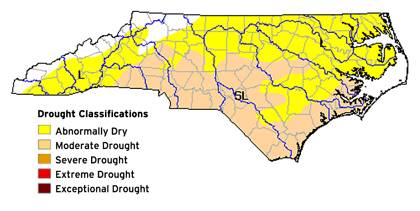Durham County 'Abnormally Dry'
Warm, dry winter leads to a warm spring

After North Carolina's eighth warmest stretch of winter, there's a good chance higher temperatures stick through April.
The month of March saw average temperatures nearly 10 degrees warmer than normal, as well as a drop in average precipitation of about 1.10 inches in the Triangle. After a dry winter, Durham County is currently listed as "abnormally dry" by the United States Drought Monitor. As part of drought status, the North Carolina Drought Management Advisory Council suggests that water users adhere to local water use restrictions and minimize nonessential uses of water.
Read MoreDarin Figurskey, meteorologist with the National Weather Service's Raleigh office, said that the change in temperatures and precipitation this winter came from a La Nina weather system, which cools waters in the Pacific Ocean and causes dry conditions in the Carolinas. He added that the eastern portion of North Carolina received 50-to-75 percent less precipitation this winter.
"Right now there's a chance of 40-to-50 percent we receive above normal temperatures through June," Figurskey said. "With the warmer-than-normal temperatures we've seen and can expect, it's possible there could be some water concerns as we get late into the spring and early summer."
The North Carolina Drought Management Advisory Council suggests that water users adhere to locally recommended water restrictions and minimize nonessential uses of water. Since 2007, Duke has initiated several steps to conserve water on campus, including installation of tanks that gather and hold up to 10,000 gallons of storm, cistern and reclaimed water, installation of low-flow shower heads and flush valves and planting drought-tolerant landscaping across campus.
In the 2011 fiscal year, Duke used about 165 million fewer gallons of potable water when compared to the 2007 fiscal year, when Durham saw its worst drought in history. Duke's West Campus Chiller Plant #2 has been a big reason for the savings, utilizing about 40 million gallons of non-potable water from alternative sources. The plant uses that water to produce chilled water to cool campus buildings, laboratories and hospital areas.
Campus water use in the current fiscal year continues to follow the same trend set for the 2011 fiscal year, said Steve Palumbo, energy manager for Facilities Management.
"Duke is always looking for new ways to conserve water, especially since we've regularly been in drought status," Palumbo said. "As we enter what could be another dry season, it's important to focus on how we can maintain sustainable practices and get the most from our infrastructure like the chiller plants and cisterns throughout campus."